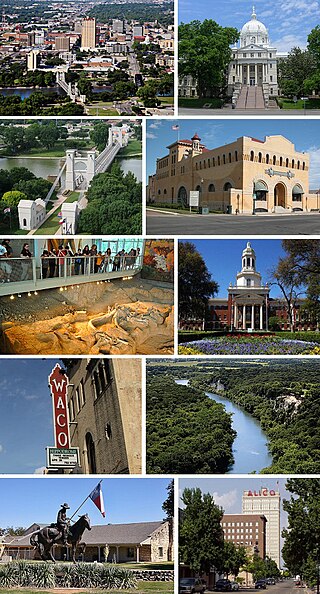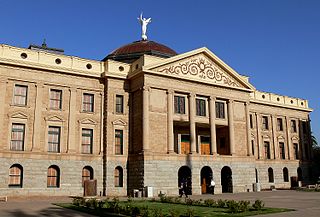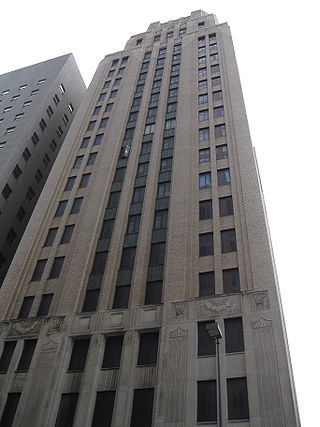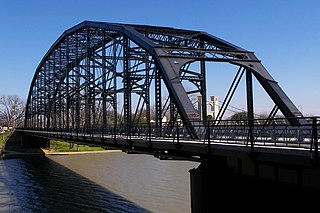
McLennan County is a county located on the Edwards Plateau in Central Texas. As of the 2020 census, its population was 260,579. Its county seat and largest city is Waco. The U.S. census 2022 county population estimate is 266,836. The county is named for Neil McLennan, an early Scottish settler who worked to evict the Indians in frontier Texas. McLennan County is included in the Waco Metropolitan Statistical Area.

Waco is a city in and the county seat of McLennan County, Texas, United States. It is situated along the Brazos River and I-35, halfway between Dallas and Austin. The city had a 2020 population of 138,486, making it the 22nd-most populous city in the state. The Waco metropolitan statistical area consists of McLennan, Falls and Bosque counties, which had a 2020 population of 295,782. Bosque County was added to the Waco MSA in 2023. The 2023 U.S. census population estimate for the Waco metropolitan area was over 300,000 residents.

The Waco Suspension Bridge crosses the Brazos River in Waco, Texas. It is a single-span suspension bridge, with a main span of 475 ft. Opened on November 20, 1869, it contains nearly 3 million bricks. It is located north of downtown Waco, connecting Indian Spring Park with Doris D. Miller Park. Every year on Independence Day, the bridge serves as a place where thousands of locals gather to watch fireworks. Indian Spring Park marks the location of the origin of the town of Waco, where the Huaco Indians had settled on the bank of the river, at the location of a cold spring.

Waco High School is a public high school located in the city of Waco, Texas and classified as a 6A school by the UIL. It is a part of the Waco Independent School District located in central McLennan County. In 2015, the school was rated “Improvement Required” by the Texas Education Agency.

The ALICO Building is a 22-story office building in downtown Waco, Texas, United States, located at the intersection of Austin and 5th Street. The building is currently owned and operated by the American-Amicable Life Insurance Company of Texas. At 282 feet (86 m) tall, it is currently the tallest building in Waco.

James Riely Gordon was an architect who practiced in San Antonio until 1902 and then in New York City, where he gained national recognition. J. Riely Gordon is best known for his landmark county courthouses, in particular those in Texas. Working during the state's "Golden Age" (1883–1898) of courthouse construction, Gordon saw 18 of his designs erected from 1885 to 1901; today, 12 remain.

Republic Center is a mixed-use complex at 300 N. Ervay Street and 325 N. St. Paul Street in the City Center District of downtown Dallas, Texas (USA), adjacent to Thanks-giving Square. The complex is located diagonally across the street from DART's St. Paul Station, which serves its Blue, Red, Orange, and Green light rail lines. It also contains part of the Dallas Pedestrian Network, with shops and restaurants in the lower levels of the building and is connected to the Bullington Truck Terminal.

One Main Place is a mixed-use skyscraper hotel and office building at 1201 Main Street in Dallas, Texas. The building rises 445 ft (136 m). It contains 33 above-ground floors, and was completed in 1968. One Main Place currently stands as the 27th-tallest building in the city. The architectural firm that designed the building was Skidmore, Owings & Merrill, which also designed the Willis Tower and John Hancock Center in Chicago and the Burj Khalifa in Dubai. Gordon Bunshaft was the lead designer of One Main Place, and a few of his notable buildings include Lever House in New York, the Beinecke Rare Book and Manuscript Library at Yale University, and the Hirshhorn Museum and Sculpture Garden in Washington, DC. The building was listed on the National Register of Historic Places in 2015.

The Tower Petroleum Building is a historic Art Deco Skyscraper located at 1907 Elm Street in the City Center District of Downtown Dallas. The tower, a contributing property in the Dallas Downtown Historic District and the Harwood Street Historic District, features Zig-zag Moderne styling and was designed by architect Mark Lemmon.

Corrigan Tower, also known as 1900 Pacific or 1900 Pacific Residences, is a high rise located at 1900 Pacific Avenue in the City Center District of Dallas, Texas. The building contains 20 floors, now made up of apartments but originally office space, and is of modernist design. It is situated on the high-traffic corner of St. Paul Street and Pacific Avenue, across from Aston Park and the future Pacific Plaza Park. It lies within the Harwood Historic District, but is not a contributing structure.

The Washington Avenue Bridge in Waco, Texas was built in 1902 and was then the longest single-span vehicular truss bridge in Texas. It has a 450-foot (140 m) span across the Brazos River. It provided for traffic circulation in addition to that provided by the 1870-built Waco Suspension Bridge one block downriver (east).

This is a list of the National Register of Historic Places listings in McLennan County, Texas.

Sanguinet & Staats was an architectural firm based in Fort Worth, Texas, with as many as five branch offices in Texas. The firm specialized in steel-frame construction and built many skyscrapers in Texas. The firm also accepted commissions for residential buildings, and designed many buildings listed on the National Register of Historic Places.

Dallas Hall is a historic building on the campus of Southern Methodist University (SMU) in University Park, Texas. Influenced by the Roman Pantheon and architecture by Thomas Jefferson, it was constructed by the architectural firm of Shepley, Rutan and Coolidge in 1915. The first building on campus, it housed most of the university's operations. The campus has since been expanded around Dallas Hall, but it remains the center of SMU. It was named to the National Register of Historic Places in 1978.
Charles William Bulger was an architect in the United States, born in Delphi, Indiana. He worked with Isaac Rapp in Trinidad, Colorado, at Bulger and Rapp for several years, designing many of the city's early buildings. The firm dissolved in 1892.

The Hopkins County Courthouse is a historic courthouse located in Sulphur Springs, Texas, the seat of Hopkins County. It was designed by San Antonio-based architect James Riely Gordon and constructed in 1894 and 1895. The courthouse was built in the Romanesque Revival architectural style with red sandstone and pink granite, and its design includes a number of unusual features, such as a double-helix staircase, a clockless tower, and entrances that are located on its northwest and southwest corners, instead of on its sides.
The following is a timeline of the history of the city of Waco, Texas, US.
James Edward Flanders was an American architect. He designed houses, courthouses and Masonic buildings in Texas, many of which are listed on the National Register of Historic Places.
First United Methodist Church is a church at 4901 Cobbs Drive in Waco, Texas.
Harry A. Overbeck (1861–1942) was an American architect. He was active in Omaha, Nebraska and then for most of his career in Dallas, Texas. He designed several prominent buildings including a Mississippi Landmark and properties on the National Register of Historic Places.



















